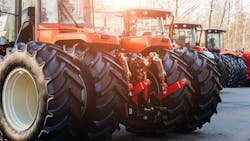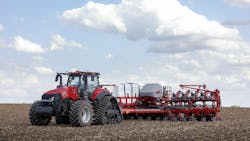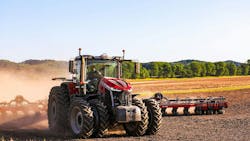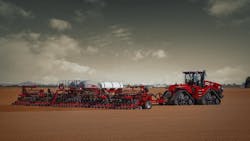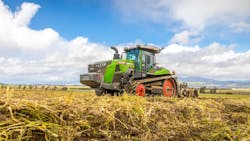Agricultural Equipment Requires Smarter, More Efficient Hydraulics
Key Highlights
- Hydraulics for agricultural equipment are evolving to become more efficient and intelligent to help meet industry trends such as automation and sustainability.
- Greater integration of sensors and controls into hydraulic systems will be needed in the coming years to enhance precision and enable self-diagnosis capabilities.
- Use of electronically controlled hydraulics in the agricultural equipment industry will continue to grow as a means of improving machine performance and efficiency.
Hydraulic systems remain integral to the functionality of tractors, combines and other agricultural equipment. As these machines continue to evolve, so too do the hydraulic components and systems utilized within them.
Automation is becoming increasingly prevalent in the agricultural equipment industry to help overcome labor challenges, necessitating development of hydraulics with built-in intelligence and improved precision.
Efficiency has gained in importance as well in recent years due to rising fuel costs. By utilizing more efficient hydraulic components and systems, less fuel is consumed during machine operation which can help reduce the amount of money farmers need to spend on fuel.
To gain a better understanding of how these and other trends are impacting hydraulics used in agricultural equipment, Power & Motion spoke with Cody Franzen, Lead for Engineering, Hydraulic & Transmission, Crop Care Platforms at AGCO, and Stefano Fiorati, Ph.D, Director – Powertrain Innovation at CNH, who offered their insights on what OEMs in the agriculture industry are looking for now and in the future from the hydraulic components and systems they will be using in their machine designs.
*Editor’s note: Questions and responses have been edited for clarity.
Power & Motion: How have you seen hydraulic systems utilized in agricultural equipment evolve in the past 3-5 years?
Cody Franzen, AGCO: In the agricultural equipment sector, ongoing advancements are focusing on automating additional vehicle and implement functions through the integration of electronics and controls. Hydraulic component manufacturers are increasingly moving beyond supplying base components by offering comprehensive vehicle or system solutions to better meet evolving industry needs.
Stefano Fiorati, CNH: What I've seen in terms of evolution has predominantly been [related to] efficiency improvements of components as well as systems. In the last 3-5 years I have seen a lot of focus on this aspect.
And in the last couple of years, I have seen a focus on improving the hydraulic systems of tractors and implements. In the past, with certain machines the hydraulics coming from the tractor worked against the hydraulics from the implements, causing problems with efficiency. So, I’ve seen a sort of harmonization to make sure that the overall efficiency is improved.
Power & Motion: What is driving that focus on improving efficiency?
Stefano Fiorati, CNH: At CNH we have a focus on continuous improvement of the efficiency of our products, because efficiency means fuel savings. At the end of the day, that means money saved for the customer, so that is definitely one important focus. But another driver is sustainability. We are looking to reduce CO2 (carbon dioxide) emissions, and as soon as we start to touch efficiency [it leads] not only to fuel savings but also CO2 reductions.
Watch our video interview below with Lucas Knapp, Vice President of Product & Marketing at HARTING and Dr. Andreas Schumacher, Senior Director, Head of Sustainability and Product Compliance at Danfoss Power Solutions, to learn more about how creation and use of energy efficient components can help achieve sustainability goals.
Power & Motion: What features or capabilities are you looking for from a hydraulics component or system that will be integrated into a machine?
Cody Franzen, AGCO: The selection of hydraulic components is influenced by the specific application, but generally, there is a strong preference for components that feature reliably integrated feedback sensors, robust sealing solutions, and advanced coatings designed to withstand UV (ultraviolet) exposure and corrosion. These qualities are essential for maintaining performance and durability in the demanding environments often encountered in agricultural operations.
Stefano Fiorati, CNH: At the CNH Investor Day 2025, our CEO shared the need for combining the iron aspect of our machines with the precision technology of our machines. That needs to be translated to all the subsystems of the vehicle. If we look at this with particular attention to the hydraulics system, one of the needs is to improve the controllability of hydraulic actuators in a way that makes them more precise through electronic control. That will have a lot of impact on precision technology, because the precision technology is connected to the automation of a machine. If I'm able to control properly basic functions, I'm able to improve the automation of my equipment, and so I can have more productivity, [more crop] yield and so on for the farmer. So that is the path we are following.
Related to the point of combining iron and precision technology, we need to add intelligence; that means additional sensors. Also self-diagnosis…as soon as we have more sensors on the component, on the hydraulic system, we are able to better monitor the health of the system and so improve for the customer aspects like downtime and serviceability. If we are able to say in advance ‘this pump is going to fail in few days because it's already giving signs of degradation’ that is important [to preventing downtime for customers]. What I see [is the need] to have more intelligence, that means more sensors, and also better controllability of the hydraulic actuators; those are the main capabilities for the future of on top of efficiency, that will not disappear.
Power & Motion: Are you finding this type of technology is already available in the market?
Stefano Fiorati, CNH: Some of it is already available and some is still in the development phase by different hydraulic component manufacturers. And it takes time and investment for an OEM to add it to vehicles. We are all looking to understand the cost benefit [of using these technologies]. It will take some time but everything is going in that direction. It’s a matter of having real implementation of all these new electronically controlled components because there are also aspects related to safety for functions that today are hydraulically driven. As soon as we want to jump to electronically controlled hydraulics, we need to also check the functional safety aspect, and this sometimes takes time and adjustments.
Power & Motion: Are there instances in which you are replacing, or considering replacing, hydraulics with an electric or other alternative technology option? If so, when and why might it make sense to replace hydraulics?
Cody Franzen, AGCO: Alternative technologies have been tried out in a variety of current and legacy products and systems. If switching to an alternative approach offers better efficiency, performance, or cost for customers, it gets strong consideration.
Sometimes, customer requests or special application needs lead to using these alternatives. Still, many alternatives end up being more expensive than hydraulic components, which is a key factor when weighing the pros and cons.
Stefano Fiorati, CNH: We have seen in some equipment that electrification is already available because hydraulic actuation [does not provide enough control] as I was referencing before. CNH has examples in our products, such as our planters in North America. In the row unit, there are 12V electric actuators; it's 12V, so it's electrification from a pure engineering point of view.
There is much more that we can do, because we see that for those functions of the vehicle that are strictly related to precise tasks, there is a general trend toward understanding how we can replace hydraulic with electric actuators because of the controllability. And because we can have more [flexibility in] the design of the machine. Think about a hydraulic actuator — you always need oil and hoses, sometimes rigid hoses, and you are sometimes constrained [with integrating components in] certain positions. With electric actuators, you have cables that you can bend much easier, so you have greater installation freedom which can be a benefit.
Of course, what I'm talking about here are low voltage applications, meaning below 60V. That is the limit for safety reasons. We also see, very long term, a potential replacement of high-power demanding functions that today are hydraulic with an electric motor. This would be high-voltage applications of 400, 700, and 800V like we are seeing in the automotive industry. Today, this is not feasible because hydraulics still have a [higher] power density versus electric actuators. But in the future, we may see a trend shifting towards full electric applications. In agriculture, there are applications that are much more sensitive to oil leaks, for example, and they want to get rid of the oil as soon as they can. These are related to high value crops, like vegetables, carrots, olives, and vineyards, and so these could become the niche markets where we will see in the future a replacement of hydraulic actuation.
Power & Motion: Do you see there always being at least some applications or parts of the machine that would need to utilize hydraulics?
Stefano Fiorati, CNH: If you consider the steering function, it’s a safety relevant function…and before jumping into a completely electrified system it will take quite some time. So probably the safety relevant functions will be the last ones to be electrified, but I’m pretty sure it will come because we already see clear examples in the market. It is not impossible from a technology point of view, it’s just a matter of finding the proper components because the power density is not yet favorable for the electric options. But as we move in that direction [of electric offering the same power density] we will see more replacement. In the short and medium term, there will be a mix with a lot of low voltage technology introduced. In the long term, probably 10 years or more, we may see more coming in the high voltage range to replace hydraulics.
Power & Motion: What challenges do you face when working with or specifying hydraulics, and what could be done to address these challenges?
Cody Franzen, AGCO: It is essential that the component manufacturer fully understands the specific application and duty cycles for which the component will be used, ensuring the component is appropriately matched to its intended environment. When designing a new system, component, or application, proper specification, thorough technical reviews, and comprehensive validation testing are necessary to confirm suitability and reliability.
Stefano Fiorati, CNH: One of the challenges is really to have these companies providing components speed up [development of products with] increased levels of intelligence. But it also makes sense [that it is taking time] because we are all coming from years…of being fully focused on the iron without a lot of precision technology. Hydraulic companies are also going through that transition, so some components are available, and some others are not. This is one of the big challenges, and again, I see the trend moving in that direction.
Another challenge from an OEM perspective is to be able to work more in simulation and modeling environments, especially for hydraulic systems. We are [undertaking] a tremendous effort to model our entire portfolio of products, all of which have hydraulics, because this will help the sustainability of research and development efforts in terms of money and time; we can speed up a lot of activities if we can use simulation.
On top of this, being able to use a modular approach with components. That, to me, is extremely important in the sense that the same component I'm using on a tractor can be reused on a combine harvester. In some cases, [it is possible] but we can further improve this aspect, and this means working with the different hydraulic component suppliers.
And then the other challenge, coming back to electronic control, is to be able to find the proper compromise between pure hydraulic, electronically controlled hydraulics and electrification. We are in a transition period, and we need to find the right compromise; we cannot jump from hydraulics to electrification in just one shot. It's feasible, but it's extremely expensive and so we need to find the proper compromise. And that is a challenge because it [all comes down to] customer acceptance. Customers of today belong to an older generation used to repairing their own machine, including hydraulic components. The moment we put sensors, electronics and software [onto the machine], we start to enter into a trend they don't like. Younger generations are more used to this kind of technology, but definitely we have this generational change that is also playing a role.
Power & Motion: How do you see the use of hydraulics in agricultural equipment evolving in the next 5 years?
Cody Franzen, AGCO: As in recent years, advancements in the near future will likely continue to focus on automating vehicle functions and shifting more vehicle operations from mechanical control to electronically controlled solutions. These developments are focused on enhancing value for farmers, making agricultural operations easier and more enjoyable to manage.
Stefano Fiorati, CNH: Certainly, we see this trend moving from current hydraulics to electronically controlled hydraulics to electrification. This enables automation…which is a big driver and so we need to have that controllability and intelligence on board. This goes together with the continuous improvement of efficiency. Not only for a single component but also, thanks to the intelligence that we will be able to add, we can change the way different hydraulic subsystems are used according to the task that the machine is doing in that specific moment. It [allows] real-time adaptation of the hydraulics in a way that we are able to gain efficiency [because] of how the components are being controlled.
We will see a lot of electronically controlled hydraulics entering [the market] with a growing presence of electrification for those really specific functions that need to be precisely controlled. That's what I see in the next 5-10 years.
About the Author
Sara Jensen
Executive Editor, Power & Motion
Sara Jensen is executive editor of Power & Motion, directing expanded coverage into the modern fluid power space, as well as mechatronic and smart technologies. She has over 15 years of publishing experience. Prior to Power & Motion she spent 11 years with a trade publication for engineers of heavy-duty equipment, the last 3 of which were as the editor and brand lead. Over the course of her time in the B2B industry, Sara has gained an extensive knowledge of various heavy-duty equipment industries — including construction, agriculture, mining and on-road trucks —along with the systems and market trends which impact them such as fluid power and electronic motion control technologies.
You can follow Sara and Power & Motion via the following social media handles:
X (formerly Twitter): @TechnlgyEditor and @PowerMotionTech
LinkedIn: @SaraJensen and @Power&Motion
Facebook: @PowerMotionTech

Leaders relevant to this article:
